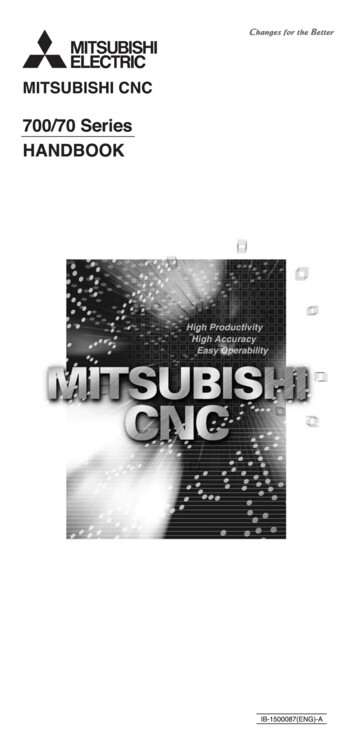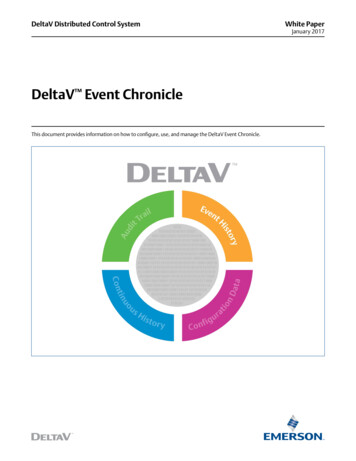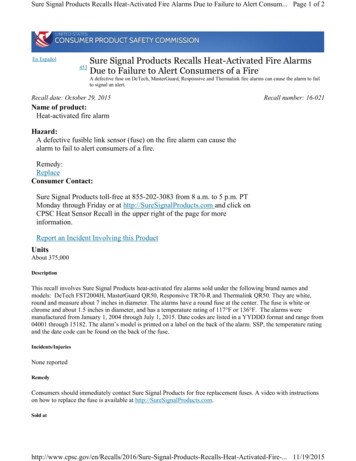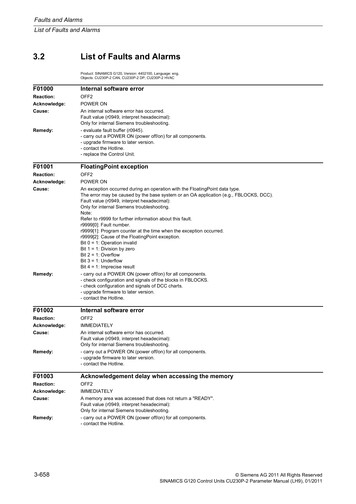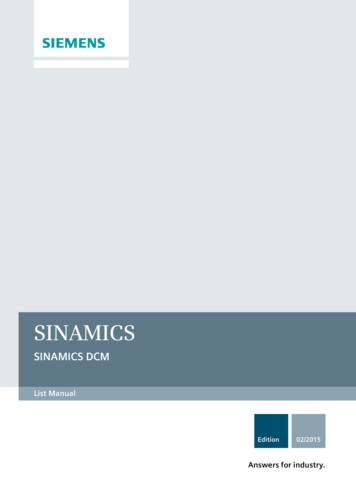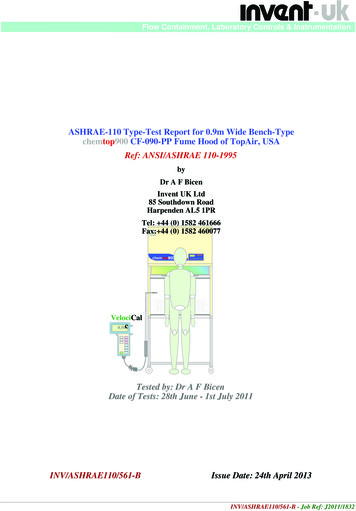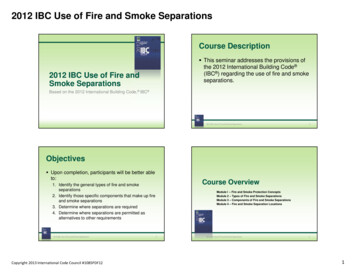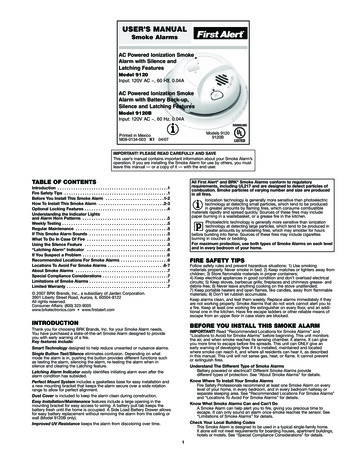
Transcription
USER’S MANUALSmoke AlarmsAC Powered Ionization SmokeAlarm with Silence andLatching FeaturesModel 9120Input: 120V AC , 60 Hz, 0.04AAC Powered Ionization SmokeAlarm with Battery Back-up,Silence and Latching FeaturesModel 9120BInput: 120V AC , 60 Hz, 0.04AModels 91209120BPrinted in MexicoM08-0134-003 K1 04/07IMPORTANT! PLEASE READ CAREFULLY AND SAVEThis user’s manual contains important information about your Smoke Alarm’soperation. If you are installing the Smoke Alarm for use by others, you mustleave this manual — or a copy of it — with the end user.TABLE OF CONTENTSAll First Alert and BRK Smoke Alarms conform to regulatoryrequirements, including UL217 and are designed to detect particles ofcombustion. Smoke particles of varying number and size are producedin all fires.Ionization technology is generally more sensitive than photoelectrictechnology at detecting small particles, which tend to be producedin greater amounts by flaming fires, which consume combustiblematerials rapidly and spread quickly. Sources of these fires may includepaper burning in a wastebasket, or a grease fire in the kitchen.Photoelectric technology is generally more sensitive than ionizationtechnology at detecting large particles, which tend to be produced ingreater amounts by smoldering fires, which may smolder for hoursbefore bursting into flame. Sources of these fires may include cigarettesburning in couches or bedding.For maximum protection, use both types of Smoke Alarms on each leveland in every bedroom of your home.Introduction . . . . . . . . . . . . . . . . . . . . . . . . . . . . . . . . . . . . . . . . . . . . . . . . .1Fire Safety Tips . . . . . . . . . . . . . . . . . . . . . . . . . . . . . . . . . . . . . . . . . . . . . .1Before You Install This Smoke Alarm . . . . . . . . . . . . . . . . . . . . . . . . . .1-2How To Install This Smoke Alarm . . . . . . . . . . . . . . . . . . . . . . . . . . . . .2-3Optional Locking Features . . . . . . . . . . . . . . . . . . . . . . . . . . . . . . . . . . . . .4Understanding the Indicator Lightsand Alarm Horn Patterns . . . . . . . . . . . . . . . . . . . . . . . . . . . . . . . . . . . . . .5Weekly Testing . . . . . . . . . . . . . . . . . . . . . . . . . . . . . . . . . . . . . . . . . . . . . . .5Regular Maintenance . . . . . . . . . . . . . . . . . . . . . . . . . . . . . . . . . . . . . . . . .5If This Smoke Alarm Sounds . . . . . . . . . . . . . . . . . . . . . . . . . . . . . . . . . . .5What To Do In Case Of Fire . . . . . . . . . . . . . . . . . . . . . . . . . . . . . . . . . . . .5Using the Silence Feature . . . . . . . . . . . . . . . . . . . . . . . . . . . . . . . . . . . . .5“Latching Alarm” Indicator . . . . . . . . . . . . . . . . . . . . . . . . . . . . . . . . . . . .6If You Suspect a Problem . . . . . . . . . . . . . . . . . . . . . . . . . . . . . . . . . . . . . .6Recommended Locations For Smoke Alarms . . . . . . . . . . . . . . . . . . . . .6Locations To Avoid For Smoke Alarms . . . . . . . . . . . . . . . . . . . . . . . . .6-7About Smoke Alarms . . . . . . . . . . . . . . . . . . . . . . . . . . . . . . . . . . . . . . . . .7Special Compliance Considerations . . . . . . . . . . . . . . . . . . . . . . . . . . . . .7Limitations of Smoke Alarms . . . . . . . . . . . . . . . . . . . . . . . . . . . . . . . . . . .7Limited Warranty . . . . . . . . . . . . . . . . . . . . . . . . . . . . . . . . . . . . . . . . . . . . .7FIRE SAFETY TIPSFollow safety rules and prevent hazardous situations: 1) Use smokingmaterials properly. Never smoke in bed. 2) Keep matches or lighters away fromchildren; 3) Store flammable materials in proper containers;4) Keep electrical appliances in good condition and don’t overload electricalcircuits; 5) Keep stoves, barbecue grills, fireplaces and chimneys grease- anddebris-free; 6) Never leave anything cooking on the stove unattended;7) Keep portable heaters and open flames, like candles, away from flammablematerials; 8) Don’t let rubbish accumulate.Keep alarms clean, and test them weekly. Replace alarms immediately if theyare not working properly. Smoke Alarms that do not work cannot alert you toa fire. Keep at least one working fire extinguisher on every floor, and an additional one in the kitchen. Have fire escape ladders or other reliable means ofescape from an upper floor in case stairs are blocked. 2007 BRK Brands, Inc., a subsidiary of Jarden Corporation.3901 Liberty Street Road, Aurora, IL 60504-8122All rights reserved.Consumer Affairs: (800) 323-9005www.brkelectronics.com www.firstalert.comINTRODUCTIONBEFORE YOU INSTALL THIS SMOKE ALARMThank you for choosing BRK Brands, Inc. for your Smoke Alarm needs.You have purchased a state-of-the-art Smoke Alarm designed to provideyou with early warning of a fire.Key features include:IMPORTANT! Read “Recommended Locations for Smoke Alarms” and“Locations to Avoid for Smoke Alarms” before beginning. This unit monitorsthe air, and when smoke reaches its sensing chamber, it alarms. It can giveyou more time to escape before fire spreads. This unit can ONLY give anearly warning of developing fires if it is installed, maintained and locatedwhere smoke can reach it, and where all residents can hear it, as describedin this manual. This unit will not sense gas, heat, or flame. It cannot preventor extinguish fires.Smart Technology designed to help reduce unwanted or nuisance alarms.Single Button Test/Silence eliminates confusion. Depending on whatmode the alarm is in, pushing the button provides different functions suchas testing the alarm, silencing the alarm, re-testing the alarm when insilence and clearing the Latching feature.Latching Alarm Indicator easily identifies initiating alarm even after thealarm condition has subsided.Perfect Mount System includes a gasketless base for easy installation anda new mounting bracket that keeps the alarm secure over a wide rotationrange to allow for perfect alignment.Dust Cover is included to keep the alarm clean during construction.Easy Installation/Maintenance features include a large opening in themounting bracket for easy access to wiring. A battery pull tab keeps thebattery fresh until the home is occupied. A Side Load Battery Drawer allowsfor easy battery replacement without removing the alarm from the ceiling orwall (Model 9120B only).Improved UV Resistance keeps the alarm from discoloring over time.Understand The Different Type of Smoke AlarmsBattery powered or electrical? Different Smoke Alarms providedifferent types of protection. See “About Smoke Alarms” for details.Know Where To Install Your Smoke AlarmsFire Safety Professionals recommend at least one Smoke Alarm on everylevel of your home, in every bedroom, and in every bedroom hallway orseparate sleeping area. See “Recommended Locations For Smoke Alarms”and “Locations To Avoid For Smoke Alarms” for details.Know What Smoke Alarms Can and Can’t DoA Smoke Alarm can help alert you to fire, giving you precious time toescape. It can only sound an alarm once smoke reaches the sensor. See“Limitations of Smoke Alarms” for details.Check Your Local Building CodesThis Smoke Alarm is designed to be used in a typical single-family home.It alone will not meet requirements for boarding houses, apartment buildings,hotels or motels. See “Special Compliance Considerations” for details.1
BEFORE YOU INSTALL THIS SMOKE ALARM, ContinuedELECTRICAL SHOCK HAZARD. Turn off the power to the area where theSmoke Alarm is installed before removing it from the mounting bracket.Failure to turn off the power first may result in serious electrical shock,injury or death. This unit will not alert hearing impaired residents. It is recommendedthat you install special units which use devices like flashing strobelights to alert hearing impaired residents. Installation of this unit must conform to the electrical codes in yourarea; Articles 210, 760 of NFPA 70 (NEC), NFPA 72, NFPA 101; ICC;SBC (SBCCI); UBC (ICBO); NBC (BOCA); OTFDC (CABO), and anyother local or building codes that may apply. Wiring and installationmust be performed by a licensed electrician. Failure to follow theseguidelines may result in injury or property damage. This unit must be powered by a 24-hour, 120V AC pure sine wave60 Hz circuit. Be sure the circuit cannot be turned off by a switch,dimmer, or ground fault circuit interrupter. Failure to connect this unitto a 24-hour circuit may prevent it from providing constant protection.Unit may be connected to an arc fault circuit interrupter. This Smoke Alarm must have AC or battery power to operate.If the AC power fails, battery back-up will allow the alarm to soundfor at least 4 minutes. If AC power fails and the battery is weak,protection should last for up to 7 days. If AC power fails and thebattery is dead or missing, the alarm cannot operate. Never disconnect the power from an AC powered unit to stop anunwanted alarm. Doing so will disable the unit and remove yourprotection. In the case of a true unwanted alarm open a window orfan the smoke away from the unit. The alarm will reset automaticallywhen it returns to normal operation. Never remove the batteries froma battery operated unit to stop an unwanted alarm (caused by cookingsmoke, etc.). Instead open a window or fan the smoke away from theunit. The alarm will reset automatically. Connect this unit ONLY to other compatible units. See “How ToInstall This Smoke Alarm” for details. Do not connect it to any othertype of alarm or auxiliary device. Connecting anything else to this unitmay damage it or prevent it from operating properly. The battery compartment resists closing unless a battery isinstalled. This warns you the unit will not operate under DC powerwithout a battery. Do not paint over the unit. Paint may clog the openings to thesensing chamber and prevent the unit from operating properly.HOW TO INSTALL THIS SMOKE ALARMThis Smoke Alarm is designed to be mounted on any standard wiring junction box to a 4-inch (10 cm) size, on either the ceiling or wall. Read “RecommendedLocations For Smoke Alarms” and “Locations to Avoid For Smoke Alarms” before you begin installation.Tools you will need: Needle-nose pliers or utility knife Standard Flathead screwdriver.Make sure the Alarm is not receiving excessively noisy power. Examples of noisy power could be major appliances on the same circuit, power from agenerator or solar power, light dimmer on the same circuit or mounted near fluorescent lighting. Excessively noisy power may cause damage to yourAlarm.THE PARTS OF THIS SMOKE ALARM1The Mounting Bracket:To remove the mounting bracket from the SmokeAlarm base, hold the Smoke Alarm base firmly andtwist the mounting bracket counterclockwise.The mounting bracket installs onto the junction box.It has a variety of screw slots to fit most boxes.3The Parts of This Unit122The Power Connector:The power connector plugs into a power input block onthe Smoke Alarm. It supplies the unit with AC power.36Mounting Bracket2Mounting Slots3Locking Pins (break out of bracket)4Hot (Black) AC Wire5Neutral (White) AC Wire6Interconnect (Orange) Wire The black wire is “hot.”7Latch to Open Battery Compartment The white wire is neutral.8Swing-Out Battery Compartment9Quick-Connect Power Connector4758 The orange wire is used for interconnect.9If you need to remove the power connector, insert aflat screwdriver blade between the power connectorand the security tab inside the power input block.Gently pry back the tab and pull the connector free.2
FOLLOW THESE INSTALLATION STEPSThe basic installation of this Smoke Alarm is similar whether you wantto install one Smoke Alarm, or interconnect more than one Smoke Alarm.If you are interconnecting more than one Smoke Alarm, you MUST read“Special Requirements For Interconnected Smoke Alarms” below beforeyou begin installation.9. For new construction, place supplied dust cover over Alarm to preventdamage from dust and construction debris. When construction is complete, remove cover.Smoke will not be able to reach smoke sensor while cover is in place.Cover must be removed!ELECTRICAL SHOCK HAZARD. Turn off power to the area where youwill install this unit at the circuit breaker or fuse box before beginninginstallation. Failure to turn off the power before installation may resultin serious electrical shock, injury or death.SPECIAL REQUIREMENTS FOR INTERCONNECTED SMOKE ALARMS1. Using wire nuts, connect the power connector to the household wiring. Failure to meet any of the above requirements could damage theunits and cause them to malfunction, removing your protection.Improper wiring of the power connector or the wiring leading to thepower connector will cause damage to the Alarm and may lead to anon-functioning Alarm. AC and AC/DC Smoke Alarms can be interconnected. Under ACpower, all units will alarm when one senses smoke. When power isinterrupted, only the AC/DC units in the series will continue to sendand receive signals. AC powered Smoke Alarms will not operate.STAND-ALONE ALARM ONLY: Connect the white wire on the power connector to the neutral wirein the junction box. Connect the black wire on the power connector to the hot wire inthe junction box. Tuck the orange wire inside the junction box. It is used forinterconnect only.Interconnected units can provide earlier warning of fire than stand-alone units,especially if a fire starts in a remote area of the dwelling. If any unit in theseries senses smoke, all units will alarm. To determine which Smoke Alarminitiated an alarm, see table:During an Alarm:On Initiating Alarm(s) Red LED(s) flashes (flash) rapidlyOn All Other AlarmsINTERCONNECTED UNITS ONLY:Strip off about 1/2” (12 mm) of the plastic coating on the orangewire on the power connector. Red LED is OffAfter an Alarm (Latching):On Initiating Alarm(s) Green LED(s) On for 2 seconds/Off for 2 secondsConnect the white wire on the power connector to the neutral wirein the junction box.Connect the black wire on the power connector to the hot wire inthe junction box.Connect the orange wire on the power connector to the interconnectwire in the junction box. Repeat for each unit you are interconnecting.Never connect the hot or neutral wires in the junction box to the orangeinterconnect wire. Never cross hot and neutral wires between Alarms.On All Other AlarmsGreen LED(s) On, Red LED(s) is OffCompatible Interconnected UnitsInterconnect units within a single family residence only. Otherwise all households will experience unwanted alarms when you test any unit in the series.Interconnected units will only work if they are wired to compatible units andall requirements are met. This unit is designed to be compatible with:First Alert Smoke Alarm Models SA4120, SA4121B, SA100B and BRKElectronics Smoke Alarm Models 9120, 9120B, SC6120B, SC9120B, 7010,7010B, 100S, 4120, 4120B, 4120SB, RM3 (Relay Module); BRK Electronics CO Alarm Models CO5120BN, CO5120PDBN; BRK Electronics Heat AlarmModels HD6135F and HD6135FB.2. Remove the mounting bracket from the base, and attach it to thejunction box.3. Plug the power connector into the back of the Smoke Alarm.4. Position the base of the Smoke Alarm over the mounting bracket andturn. The Alarm will remain secure over a wide rotation range to allow forperfect alignment. When wall mounting, this will allow fine-tuning on thepositioning to compensate for misaligned wall studs and to keep thewording level. The Alarm can be positioned over the bracket every 120 .Rotate the Alarm until aligned properly.Interconnected units must meet ALL of the following requirements: A maximum of 18 compatible units may be interconnected(Maximum of 12 Smoke Alarms). The same fuse or circuit breaker must power all interconnected units. The total length of wire interconnecting the units should be less than1000 feet (300 meters). This type of wire is commonly available atHardware and Electrical Supply stores. All wiring must conform to all local electrical codes and NFPA 70 (NEC).Refer to NFPA 72, NFPA 101, and/or your local building code for furtherconnection requirements.5. Check all connections.STAND-ALONE ALARM ONLY: If you are only installing one Smoke Alarm, restore power to thejunction box.INTERCONNECTED UNITS ONLY: If you are interconnecting multiple Smoke Alarms, repeat steps1-5 for each Smoke Alarm in the series. When you are finished,restore power to the junction box.A54321ELECTRICAL SHOCK HAZARD. Do not restore power until all SmokeAlarms are completely installed. Restoring power before installation iscomplete may result in serious electrical shock, injury or death.6. Make sure the Smoke Alarm is receiving AC power. Under normaloperation, the Green power indicator light will shine continuously.7. If the Green power indicator light does not light, TURN OFF POWER TOTHE JUNCTION BOX and recheck all connections. If all connectionsare correct and the Green power indicator still does not light when yourestore the power, the unit should be replaced immediately.A. Unswitched 120VAC60 Hz source1. Smoke Alarm2. Ceiling or Wall3. Power Connector8. Single Station Alarms: Test each Smoke Alarm. Press and hold theTest/Silence button until the unit alarms.Interconnected Alarms: Press and hold the Test/Silence button untilthe unit alarms. All interconnected Alarms should sound. The otherAlarms sounding only tests the interconnect signal between Alarms.It does not test each Alarm’s operation. You must test each Alarmindividually to check if the Alarm is functioning properly.If any unit in the series does not alarm, TURN OFF POWER and recheckconnections. If it does not alarm when you restore power, replace itimmediately.367 B8}}5431B. To additional units; Maximum 18 total(Maximum 12 Smoke Alarms)4. Wire Nut5. Junction Box6. Neutral Wire (Wht)7. Interconnect Wire(Orange)8. Hot Wire (Blk)
OPTIONAL LOCKING FEATURESThe optional locking features are designed to discourage unauthorized removal of the battery or alarm. It is not necessary to activate the locks insingle-family households where unauthorized battery or alarm removal is not a concern.These Smoke Alarms have two separate locking features: one to lock the battery compartment, and the other to lock the Smoke Alarmto the mounting bracket. You can choose to use either feature independently, or use them both.Tools you will need: Needle-nose pliers or utility knife Standard Flathead screwdriver.Locking PinBoth locking features use locking pins, which are molded into the mounting bracket. Using needle nose pliers or a utility knife, remove oneor both pins from the mounting bracket, depending on how many locking features you want to use.To permanently remove either lock insert a flathead screwdriver between the locking pin and the lock, and pry the pin out of the lock.TO LOCK THE BATTERY COMPARTMENTTO UNLOCK THE BATTERY COMPARTMENT(Model 9120B Only)(Model 9120B Only)Do not lock the battery compartment until you have activatedthe battery and tested the battery back-up.Once the Smoke Alarm is installed, you must disconnect it from the AC powerbefore unlocking the battery compartment.1. Activate the battery back-up by removingthe “Pull to Activate Battery Back-Up” tab.2. Push and hold test button until the alarmsounds: 3 beeps, pause, 3 beeps, pause.ELECTRICAL SHOCK HAZARD. Turn off the power to the area where theSmoke Alarm is installed before removing it from the mounting bracket.Failure to turn off the power first may result in serious electrical shock,injury or death.If the unit does not alarm during testing,DO NOT lock the battery compartment!Install a new battery and test again.If the Smoke Alarm still does not alarm,replace it immediately.Always discharge the branch circuit before servicing an AC or AC/DCSmoke Alarm. First, turn off the AC power at the circuit breaker or fusebox. Next, remove the battery from Smoke Alarms with battery back-up.Finally, press and hold the test button for 5-10 seconds to discharge thebranch circuit.1. Remove the Smoke Alarm from the mountingbracket. If the unit is locked to the bracket, seethe section “To Unlock the Mounting Bracket.”2. Disconnect the power connector by gently pryingit away from the back of the Smoke Alarm.3. Insert a flathead screwdriver under the head ofthe locking pin, and gently pry it out of the battery compartment lock. (If you plan to relock thebattery compartment, save the locking pin.)3. Using needle-nose pliers or a utilityknife, detach one locking pin fromthe mounting bracket.4. Push the locking pin through theblack dot on the label on the backof the Smoke Alarm.4. To relock the battery compartment, close the battery door and reinsertlocking pin in lock.5. Reconnect the power connector to the back of the Smoke Alarm, reattachthe Smoke Alarm to the mounting bracket, and restore the power.When replacing the battery, always test the Smoke Alarm before relocking thebattery compartment.TO UNLOCK THE MOUNTING BRACKETTO LOCK THE MOUNTING BRACKET1. Using needle-nose pliers or utilityknife, detach one locking pin frommounting bracket.ELECTRICAL SHOCK HAZARD. Turn off the power to the area where theSmoke Alarm is installed before removing it from the mounting bracket.Failure to turn off the power first may result in serious electrical shock,injury or death.2. Insert the locking pin into thelock located on the base asshown in the diagram.Always discharge the branch circuit before servicing an AC or AC/DCSmoke Alarm. First, turn off the AC power at the circuit breaker or fusebox. Next, remove the battery from Smoke Alarms with battery back-up.Finally, press and hold the test button for 5-10 seconds to discharge thebranch circuit.3. When you attach the SmokeAlarm to the mountingbracket, the locking pin’shead will fit into a notch onthe bracket.1. Insert a flathead screwdriver between the mounting bracket pin and themounting bracket.2. Pry the Smoke Alarm away from the bracket by turning both the screwdriver and the Smoke Alarm counterclockwise (left) at the same time.4
Choosing a replacement battery:Your Smoke Alarm requires one standard 9V battery. The following batteriesare acceptable as replacements: Duracell #MN1604, (Ultra) #MX1604;Eveready (Energizer) #522, Eveready (Energizer) #1222. You may also use aLithium battery like the Ultralife U9VL-J for longer service life between batterychanges. These batteries are available at many local retail stores.UNDERSTANDING THE INDICATOR LIGHTSAND ALARM HORN PATTERNSConditionLED (Red or GreenLights)HornNormal Operation(AC Power)Green LED ON; flashing Red LED once/minuteNo Audible AlarmNormal Operation(DC Power – 9120Bonly)Green LED OFF;Red LED flashesonce/minuteNo Audible AlarmDURING TESTINGRed LED flashesonce everysecondHorn pattern:3 beeps, pause, 3beeps, pauseLOW OR MISSINGBATTERY (9120Bonly)Red LED flashesonce/minuteHorn “chirps”once/minuteALARM CONDITIONSmoke InitiatingDeviceRed LED flashesrapidly on theunit thattriggered the Alarm.Horn pattern:3 beeps, pause, 3beeps, pause repeating on all AlarmsALARM CONDITIONInterconnect AlarmRed LED on theother Alarms inan interconnectedseries will be OFF.Horn pattern:3 beeps, pause, 3beeps, pause repeating on all AlarmsIN SILENCE MODERed LED flashesonce every 10secondsHorn remains silentfor up to 10 minutes.Horn will sound ifsmoke levels increase.“LATCHING” ALARMINDICATORGreen LED ON for2 seconds/OFFfor 2 seconds,repeatedly until reset,on initiating unit(s).Horn remains silentActual battery service life depends on the Smoke Alarm and the environment inwhich it is installed. All the batteries specified above are acceptable replacement batteries for this unit. Regardless of the manufacturer’s suggested batterylife, you MUST replace the battery immediately once the unit starts “chirping”(the “low battery warning”).IF THIS SMOKE ALARM SOUNDSRESPONDING TO AN ALARMDuring an alarm, you will hear a loud, repeating horn pattern: 3 beeps,pause, 3 beeps, pause. If the unit alarms and you are not testing the unit, it is warning youof a potentially dangerous situation that requires your immediateattention. NEVER ignore any alarm. Ignoring the alarm may resultin injury or death. Never disconnect the AC power to quiet an unwanted alarm.Disconnecting the power disables the Alarm so it cannot sensesmoke. This will remove your protection. Instead open a windowor fan the smoke away from the unit. The alarm will reset automatically. If the unit alarms get everyone out of the house immediately. ELECTRICAL SHOCK HAZARD: Attempting to disconnect the powerconnector from the unit when the power is on may result in electricalshock, serious injury or death.When an interconnected system of AC powered units is in alarm, the alarmindicator light on the unit(s) that initiated the alarm will blink rapidly. It willremain OFF on any remaining units.If the unit alarms and you are certain that the source of smoke is not a fire—cooking smoke or an extremely dusty furnace, for example—open a nearbywindow or door and fan the smoke away from the unit. Use the SilenceFeature to silence the alarm. This will silence the alarm, and once the smokeclears the unit will reset itself automatically.WEEKLY TESTINGNEVER use an open flame of any kind to test this unit. You might accidentally damage or set fire to the unit or to your home. The built-in testswitch accurately tests the unit’s operation as required by UnderwritersLaboratories, Inc. (UL). If you choose to use an aerosol smoke productto test the Smoke Alarm, be certain to use one that has been Listed toUnderwriters Laboratories, Inc. Safety Standards, and use it only asdirected. Use of non-UL Listed products or improper use of UL Listedproducts may affect the Smoke Alarm’s sensitivity.WHAT TO DO IN CASE OF FIRE DO NOT stand close to the Alarm when the horn is sounding. Exposureat close range may be harmful to your hearing. When testing, step awaywhen horn starts sounding.It is important to test this unit every week to make sure it is working properly. Using the test button is the recommended way to test this SmokeAlarm. Press and hold the test button on the cover of the unit until the alarmsounds (the unit may continue to alarm for a few seconds after you release thebutton). If it does not alarm, make sure the unit is receiving power and test itagain. If it still does not alarm, replace it immediately. During testing, you willhear a loud, repeating horn pattern: 3 beeps, pause, 3 beeps, pause.When testing a series of interconnected units you must test each unit individually. Make sure all units alarm when each one is tested. Alarms have various limitations. See "Limitations of Smoke Alarms" fordetails.USING THE SILENCE FEATUREREGULAR MAINTENANCEThe Silence Feature on this unit can temporarily quiet an unwanted alarm forup to 10 minutes.Use only the replacement batteries listed below. The unit may notoperate properly with other batteries. Never use rechargeable batteriessince they may not provide a constant charge.The Silence Feature does not disable the unit—it makes it temporarilyless sensitive to smoke. For your safety, if smoke around the unit isdense enough to suggest a potentially dangerous situation, the unit willstay in alarm or may re-alarm quickly. If you do not know the source ofthe smoke, do not assume it is an unwanted alarm. Not responding toan alarm can result in property loss, injury, or death. If the unit will notsilence and no heavy smoke is present, or if it stays in silence modecontinuously, it should be replaced immediately.This unit has been designed to be as maintenance-free as possible, but thereare a few simple things you must do to keep it working properly. Don’t panic; stay calm. Follow your family escape plan.Get out of the house as quickly as possible. Don’t stop to get dressed orcollect anything.Feel doors with the back of your hand before opening them. If a door iscool, open it slowly. Don’t open a hot door. Keep doors and windowsclosed, unless you must escape through them.Cover your nose and mouth with a cloth (preferably damp). Take short,shallow breaths.Meet at your planned meeting place outside your home, and do a headcount to make sure everybody got out safely.Call the Fire Department as soon as possible from outside. Give youraddress, then your name.Never go back inside a burning building for any reason.Contact your Fire Department for ideas on making your home safer.Test it at least once a week.Clean the Smoke Alarm at least once a month; gently vacuum theoutside of the Smoke Alarm using your household vacuum’s soft brushattachment. Test the Smoke Alarm. Never use water, cleaners or solventssince they may damage the unit.If the Smoke Alarm becomes contaminated by excessive dirt, dust and/orgrime, and cannot be cleaned to avoid unwanted alarms, replace the unitimmediately.Relocate the unit if it sounds frequent unwanted alarms. See “LocationsTo Avoid For Smoke Alarms” for details.When the battery back-up becomes weak, the Smoke Alarm will “chirp”about once a minute (the low battery warning). This warning should last 7days, but you should replace the battery immediately to continue yourprotection.To silence Smoke Alarms in an interconnected series:1. To silence multiple alarms in an interconnected series, you must press theTest/Silence button on the unit(s) that initiated the alarm.NOTE: The red LED on the initiating alarm will flash rapidly. The red LEDwill be Off on all other non-initiating alarms. No audible sound will beheard. The unit will exit “silence mode” in approximately 10 minutes.2. While the unit is in “silence mode”, pressing and holding the Test/Silencebutton for approximately 10 seconds will test the unit. After testing, theunit will re-enter “silence mode” and the 10-minute timer is reset.5
RECOMMENDED LOCATIONS FOR SMOKE ALARMS, Continued“LATCHING ALARM” INDICATORBEDROOMBEDROOMKITCHENLIVING ROOMBEDROOMGARAGEKEY:LATCHING ALARM:Unit was exposedto alarm levels of SmokeHALLBASEMENTLATCHING NOT ACTIVATED:Unit was not exposedto alarm levels of SmokeThe Latching Alarm
This user’s manual contains important information about your Smoke Alarm’s operation. If you are installing the Smoke Alarm for use by others, you must leave this manual — or a copy of it — with the end user. Models 9120 Printed in Mexico 9120B M08-0134-003 K1 04/07 All First
